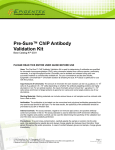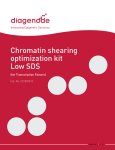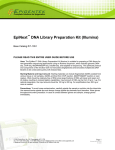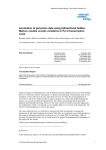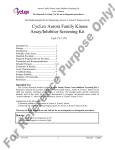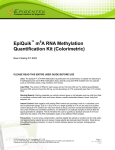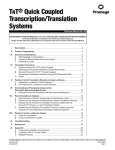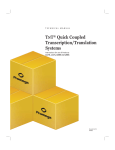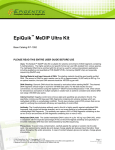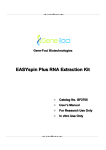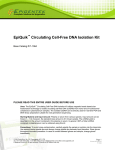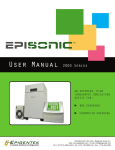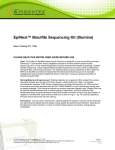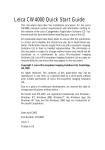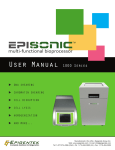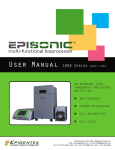Download EpiQuik™ Chromatin Accessibility Assay Kit
Transcript
EPIGENTEK Complete Solutions for Epigenetics EpiQuik™ Chromatin Accessibility Assay Kit Base Catalog # P-1047 PLEASE READ THIS ENTIRE USER GUIDE BEFORE USE Uses: The EpiQuik™ Chromatin Accessibility Assay Kit is a complete set of optimized reagents designed for conducting a gene-specific analysis of chromatin accessibility including nucleosome/transcription factor positioning from various biological samples via real time PCR. Starting Materials: Starting materials can include various mammalian tissue or cell samples such as cells from flask or microplate cultured cells, fresh and frozen tissues, etc. Input Amount of Cell/tissues: The amount of cells/tissues for each reaction can be from 1 x 105 cells or 2 mg tissues to 2 x 106 cells or 40 mg tissues. For an optimal reaction, the input chromatin amount should be about 0.5 x 106 cells or 10 mg tissues. Internal Controls: The positive control and reference primers are included in the kit, which can be used to determine if chromatin digestion is successfully achieved and to analyze the extent of chromatin accessibility in a specified gene target with the sample DNA. The positive control primers target the gene regions in opened chromatin (euchromatin) that is accessible to and digested by exogenous nucleases. A qPCR assay of euchromatin shows a large Ct shift between digested and undigested samples. The negative control primers target the gene regions in the closed chromatin (heterochromatin) that is inaccessible to and undigested by exogenous nucleases. A qPCR assay of heterochromatin shows an insignificant Ct shift between digested and undigested samples. Precautions: To avoid cross-contamination, carefully pipette the sample or solution into the tube or vials. Use aerosol-barrier pipette tips and always change pipette tips between liquid transfers. Wear gloves throughout the entire procedure. In case of contact between gloves and sample, change gloves immediately. 110 Bi County Blvd. Ste. 122, Farmingdale, NY 11735 Tel: 1-877-374-4368 ■ Fax: 1-718-484-3956 ■ E-mail: [email protected] ■ Web: www.epigentek.com © Epigentek Group Inc. All rights reserved. Products are for research use only. Page 1 Printed 2015-07-22 P-1047 EPIGENTEK Complete Solutions for Epigenetics KIT CONTENTS Component 48 Reactions Cat. #P-1047-48*** Storage Upon Receipt LB (10X Lysis Buffer) 11 ml RT WB (10X Wash Buffer) 10 ml 4°C PIC (1000X Protease Inhibitor Cocktail)* 50 µl 4°C NDB (Nuclear Digestion Buffer) 3 ml 4°C Nse (Nuclease Mix)* 50 µl -20°C RSS (Reaction Stop Solution) 0.5 ml RT PK (Proteinase K,10 mg/ml)* 110 µl 4°C DBS (DNA Binding Solution) 15 ml RT DWS (10X DNA Washing Solution) 3 ml RT ES (Elution Solution) 1 ml RT Positive Control Primer-F (20 µM)* 10 µl -20°C Positive Control Primer-R (20 µM)* 10 µl -20°C Negative Control Primer-F (20 µM)* 10 µl -20°C Negative Control Primer-R (20 µM)* 10 µl -20°C F-Spin Column** 50 RT F-Collection Tube 50 RT User Guide 1 RT * Spin the solution down to the bottom prior to use. ** Always cap spin columns before placing them in the microcentrifuge. *** For 24 samples and 24 No-Nse controls (negative control) SHIPPING & STORAGE The kit is shipped in two parts: the first part at ambient room temperature and the second part on frozen ice packs at 4°C. Upon receipt: (1) Store Nse, Positive Control Primer-F, Positive Control Primer-R, Negative Control Primer-F, and Negative Control Primer-R at –20°C away from light; (2) Store WB, PIC, NDB, and PK at 4°C away from light; (3) Store remaining components at room temperature away from light. All components of the kit are stable for 6 months from the date of shipment, when stored properly. Note: Check WB (10X Wash Buffer) for salt precipitates before use. If present, briefly warm at room temperature or 37°C and shake the buffer until the salts are re-dissolved. 110 Bi County Blvd. Ste. 122, Farmingdale, NY 11735 Tel: 1-877-374-4368 ■ Fax: 1-718-484-3956 ■ E-mail: [email protected] ■ Web: www.epigentek.com © Epigentek Group Inc. All rights reserved. Products are for research use only. Page 2 Printed 2015-07-22 P-1047 EPIGENTEK Complete Solutions for Epigenetics MATERIALS REQUIRED BUT NOT SUPPLIED Vortex mixer Dounce homogenizer Centrifuge including desktop centrifuge (up to 14,000 rpm) Incubator for 37°C and 60°C temperatures Thermal cycler with heated lid Real time PCR instrument Pipette and pipette tips 0.2 ml PCR tubes 1.5 ml microcentrifuge tubes 90% ethanol Cells or tissues Cell culture medium 1X PBS Distilled water GENERAL PRODUCT INFORMATION Quality Control: Each lot of EpiQuik™ Chromatin Accessibility Assay Kit is tested against predetermined specifications to ensure consistent product quality. Epigentek guarantees the performance of all products in the manner described in our product instructions. Product Warranty: If this product does not meet your expectations, simply call our technical support unit or your regional distributor. We also encourage you to contact us if you have any suggestions about product performance or new applications and techniques. Safety: Suitable lab coat, disposable gloves, and proper eye protection are required when working with this product. Product Updates: Epigentek reserves the right to change or modify any product to enhance its performance and design. Usage Limitation: The EpiQuik™ Chromatin Accessibility Assay Kit is for research use only and is not intended for diagnostic or therapeutic application. Intellectual Property: EpiQuik™ Chromatin Accessibility Assay Kit and methods of use contain proprietary technologies by Epigentek. 110 Bi County Blvd. Ste. 122, Farmingdale, NY 11735 Tel: 1-877-374-4368 ■ Fax: 1-718-484-3956 ■ E-mail: [email protected] ■ Web: www.epigentek.com © Epigentek Group Inc. All rights reserved. Products are for research use only. Page 3 Printed 2015-07-22 P-1047 EPIGENTEK Complete Solutions for Epigenetics A BRIEF OVERVIEW The accessibility of regulatory elements in chromatin is critical for many aspects of gene regulation. Nucleosomes positioned over regulatory elements inhibit access of transcription factors to DNA. To elucidate the role of the interactions between chromatin and transcription factors, it is crucial to determine chromatin accessibility through mapping of the nucleosome positioning along the genome. In general, the more condensed the chromatin, the more difficult it is for transcription factors and other DNA binding proteins to access DNA and carry out their tasks. The more accessible the DNA, the more likely surrounding genes are actively transcribed. The presence (or the absence) of nucleosomes directly or indirectly affects a variety of other cellular and metabolic processes such as recombination, replication, centromere formation, and DNA repair. Tanaka, Y et al: Genome Informatics (2009): the nucleosome limits the accessibility of many regulatory factors. The chromatin accessibility is one of the important clues to clarify the mechanism of regulation for various nuclear events (transcription, replication, DNA repair etc). There are several methods currently used for detecting chromatin accessibility. The traditional method is the use of DNAse I or micrococcal nuclease as a probe for chromatin accessibility. However this method may have drawbacks to limit from broad-spectrum use. For example, this method requires a significant amount of starting material and introduces assay bias because of difficult control of enzyme concentrations and digestion time, as well as the inability to function in a harsh environment. In particular, the traditional method cannot be used for tissue samples. To address these problems, Epigentek developed the EpiQuik™ Chromatin Accessibility Assay Kit that allows for the analysis of chromatin accessibility in multiple gene promoters simultaneously. The kit has the following advantages and features: Extremely fast and convenient protocol that allows the entire procedure (from cell tissue sample to ready-to-use DNA for PCR) to be finished in as short as 1 hour and 30 minutes. Able to be used with cultured cells and also fresh and frozen tissues. Fast process minimizes nuclear damage and loss of disassociated chromatin components, preserving chromatin structure. Internal control primers for human are included in the kit as references for analyzing the extent of chromatin accessibility in a specified gene target in the sample DNA, and also for validating whether the proper enzymatic digestions are achieved. Choice of single-reaction assay or high throughput multi-reaction assay can be used, making the assay flexible. 110 Bi County Blvd. Ste. 122, Farmingdale, NY 11735 Tel: 1-877-374-4368 ■ Fax: 1-718-484-3956 ■ E-mail: [email protected] ■ Web: www.epigentek.com © Epigentek Group Inc. All rights reserved. Products are for research use only. Page 4 Printed 2015-07-22 P-1047 EPIGENTEK Complete Solutions for Epigenetics PRINCIPLE & PROCEDURE Schematic Procedure of the EpiQuik Chromatin Accessibility Assay Kit. The EpiQuik™ Chromatin Accessibility Assay Kit contains all the necessary reagents required for obtaining a gene-specific analysis of chromatin accessibility from cell/tissue samples via real time PCR. This kit includes internal control primers for determining whether chromatin digestion is successfully achieved. In this assay, chromatin is isolated from the cells/tissues and is treated with a nuclease mix. DNA is then isolated and amplified with real time PCR for region-specific analysis of chromatin accessibility. Chromatin states can be identified based on how accessible the DNA is to nucleases. The DNA in heterochromatin is inaccessible to outside proteins, including exogenous nucleases, rendering it protected by nucleosome or DNA/protein complexes and becomes available for subsequent PCR with insignificant Ct shifts between digested and undigested samples. In contrast, the DNA in euchromatin (nucleosome depletion) is accessible to exogenous nucleases, making it susceptible to nuclease digestion and becomes unavailable for PCR with a large Ct shift between digested and undigested samples. REACTION PROTOCOL For the best results, please read the protocol in its entirety prior to starting your experiment. Starting Materials Starting materials can include various mammalian tissue or cell samples such as cultured cells from a flask or microplate, fresh and frozen tissues, etc. Input amount of cell/tissues for each reaction can be from 1 x 105 cells or 2 mg tissues to 1 x 106 cells or 20 mg tissues. For an optimal reaction, the input amount should be about 0.5 x 106 cells or 10 mg tissues. 1. Buffer/Solution Preparation a. 1X Lysis Buffer: Add 1 ml of LB 10X Lysis Buffer and 10 µl of PIC Protease Inhibitor Cocktail to every 9 ml of distilled water. 110 Bi County Blvd. Ste. 122, Farmingdale, NY 11735 Tel: 1-877-374-4368 ■ Fax: 1-718-484-3956 ■ E-mail: [email protected] ■ Web: www.epigentek.com © Epigentek Group Inc. All rights reserved. Products are for research use only. Page 5 Printed 2015-07-22 P-1047 EPIGENTEK Complete Solutions for Epigenetics 2. b. 1X Wash Buffer: Add 5 ml of WB 10X Wash Buffer to every 45 ml of distilled water. c. 1X DNA Washing Solution: Add 27 ml of 100% Ethanol to 3 ml of DWS 10X DNA Washing Solution. Cell/tissue Collection For Monolayer or Adherent Cells: a. Grow cells (treated or untreated) to 80%-90% confluency on a 100 mm plate (about 2x106 to 4x106 cells; 0.5x106 cells are required for each reaction), then trypsinize and collect them into a 15 ml conical tube. Count the cells using a hemocytometer if needed. b. Centrifuge the cells at 1000 rpm for 5 min. Discard the supernatant. c. Wash cells with 10 ml of PBS once by centrifugation at 1000 rpm for 5 min. Discard the supernatant. For Suspension Cells: a. Collect cells (treated or untreated) into a 15 ml conical tube. 1x 106 cells are required for each reaction. Count cells using a hemocytometer if needed. b. Centrifuge the cells at 1000 rpm for 5 min. Discard the supernatant. c. Wash cells with 10 ml of PBS once by centrifugation at 1000 rpm for 5 min. Discard the supernatant. For Tissues: 3. a. Put the tissue sample into a 60 or 100 mm plate. Remove unwanted tissue such as fat and necrotic material from the sample. b. Weigh the sample and cut the sample into small pieces (1-2 mm3) with a scalpel or scissors. c. Transfer tissue pieces to a 15 ml conical tube (10 mg tissue is required for each reaction). d. Transfer tissue pieces to a Dounce homogenizer. e. Add 400 µl of 1X Lysis Buffer for every 20 mg tissues. f. Disaggregate tissue pieces by 10-20 strokes. g. Transfer 200 µl of homogenized mixture to a 1.5 ml vial as a sample and 200 µl of homogenized mixture to another 1.5 ml vial as a no-Nse control. Centrifuge at 5000 rpm for 5 min at 4°C and then go directly to Step 3e of Cell Lysis and Chromatin Extraction below. Cell Lysis and Chromatin Extraction a. Add 1X Lysis Buffer to re-suspend the cell pellet (400 µl/1x106). b. Transfer 200 µl of cell suspension to a 1.5 ml vial as a sample and 200 µl of cell suspension to another 1.5 ml vial as a no-Nse control. 110 Bi County Blvd. Ste. 122, Farmingdale, NY 11735 Tel: 1-877-374-4368 ■ Fax: 1-718-484-3956 ■ E-mail: [email protected] ■ Web: www.epigentek.com © Epigentek Group Inc. All rights reserved. Products are for research use only. Page 6 Printed 2015-07-22 P-1047 EPIGENTEK Complete Solutions for Epigenetics 4. c. Incubate the cell suspension on ice for 10 min. d. Vortex vigorously for 10 sec and centrifuge at 5000 rpm for 5 min. e. Carefully remove supernatant and wash chromatin pellet one time with 1 ml of 1X Wash Buffer by resuspending the chromatin pellet and centrifuging at 3000 rpm for 5 min at 4°C (in bench top centrifuge). Chromatin Digestion a. Wash the chromatin pellet one time with 0.5 ml of 1X Wash Buffer by resuspending the chromatin pellet and centrifuging at 3000 rpm for 5 min at 4°C (in bench top centrifuge). b. Carefully remove supernatant. c. Prepare the Nse reaction mixture as follows. For each reaction: Sample No-Nse Control NDB Nse 48 µl 2 µl 50 µl 0 µl Total 50 µl 50 µl Mix and add 50 µl of the mixture to the chromatin sample and No-Nse control vials accordingly. 5. d. Resuspend the chromatin pellet by pipetting 3-4 times. e. Tightly cap the tube/wells and incubate at 37°C (waterbath or thermal cycler) for 4 min. f. After 4 min reaction, add 10 µl of RSS Reaction Stop Solution to each vial and incubate at 37°C for 10 min. g. Add 2 µl of PK Proteinase K to each vial and incubate at 60°C for 15 min. DNA Clean-Up a. Add 250 µl of DBS DNA Binding Solution to each column. Then transfer the samples from each PCR tube to each column containing the DBS. Cap the columns and centrifuge at 12,000 rpm for 30 sec. Remove columns from collection tubes and discard the flowthrough. Place columns back into collection tubes. b. Add 200 µl of 1X DNA Washing Solution to each column. Centrifuge at 12,000 rpm for 30 sec. Remove columns from collection tubes and discard the flowthrough. c. Repeat step b of DNA Clean-Up two times. d. Put spin column into a 1.5 ml microcentrifuge tube and centrifuge at 12,000 rpm for 1 min to dry the columns. e. Insert each column into a new 1.5 ml microcentrifuge tube. Add 20 µl of ES Elution Solution directly to each column’s filter membrane. Centrifuge at 12,000 rpm for 45 sec to elute DNA. DNA is now ready for use, or storage at or below –20°C for up to 6 months. 110 Bi County Blvd. Ste. 122, Farmingdale, NY 11735 Tel: 1-877-374-4368 ■ Fax: 1-718-484-3956 ■ E-mail: [email protected] ■ Web: www.epigentek.com © Epigentek Group Inc. All rights reserved. Products are for research use only. Page 7 Printed 2015-07-22 P-1047 EPIGENTEK Complete Solutions for Epigenetics 6. qPCR Analysis of the Samples To confirm if the samples are successfully digested and to analyze the user-specified gene targets, a real time qPCR can be performed with use of the internal control primers included in the kit. qPCR could be performed by using your own successful method. Newly designed primers should be verified for amplification efficiency by generating a standard curve with a series dilution of genomic DNA. If using Epigente’s EpiQuik™ Quantitative PCR Fast Kit (Cat. No. P-1029), follow Steps 6a and 6b below: a. Prepare the PCR Reactions Component Size (µl) Final Concentration Master Mix (2X) 10 µl 1X Forward Primer 1 µl 0.4-0.5 µM Reverse Primer 1 µl 0.4-0.5 µM DNA Template 1-2 µl 0.1 ng-0.1 µg DNA/RNA-free H2O 6-7 µl Total Volume 20 µl For the negative control, use DNA/RNAse-free water instead of DNA template. b. Program the PCR Reactions Cycle Step Temp Time Cycle Activation 95°C 7 min 1 Cycling 95°C 55°C 72°C 10 sec 10 sec 10 sec 40-45 Final Extension 72°C 1 min 1 Note: The internal control primers included in the kit are only for human species. 7. Data Analysis After qPCR Fold enrichment (FE) can be calculated by simply using a ratio of amplification efficiency of the Nse-treated DNA sample over that of the No-Nse control sample. FE = 2( Nse CT – no-Nse CT) x 100% For example, if Ct for No-Nse is 30 and the Nse sample is 34, then: FE of Nse-untreated sample = 2 (34 – 30) x 100% = 1600% The experiments are considered to be appropriate and successful if the following is achieved: With positive control primers, FE% of the untreated sample should be in general greater than 1600% compared to the Nse-treated samples, which indicates the samples are properly digested and the targeted gene region is in the opened chromatin. With Negative control primers, FE% of the 110 Bi County Blvd. Ste. 122, Farmingdale, NY 11735 Tel: 1-877-374-4368 ■ Fax: 1-718-484-3956 ■ E-mail: [email protected] ■ Web: www.epigentek.com © Epigentek Group Inc. All rights reserved. Products are for research use only. Page 8 Printed 2015-07-22 P-1047 EPIGENTEK Complete Solutions for Epigenetics untreated samples should not be greater than 400% compared to Nse-treated samples, which indicates the targeted gene region is in the closed chromatin that is not digested. Similarly, with the primers for user-specified gene targets, FE% of the untreated samples >1600% compared to the Nse-treated samples which indicates the gene region is in the opened chromatin, while FE% of the untreated samples <400% compared to the Nse-treated samples represents the gene region in closed chromatin. TROUBLESHOOTING Problem Possible Causes Suggestions Low yield of chromatin Insufficient amount of samples. To obtain the best results, the amount of 6 6 samples should be 0.5 x10 to 1x10 cells, or 10 to 20 mg tissues per ChIP reaction. Insufficient chromatin extraction. Ensure that all reagents have been added with the correct volume and in the correct order based on the sample amount. Check for sample lysis under a microscope after the tissue/cell lysis step. Ensure that the cell or tissue species are compatible with this extraction procedure. Chromatin is inappropriately digested Elute Contains Little or No DNA Lysis or extraction reagents have expired. Expired reagents may cause inefficient extraction. Ensure that the kit has not exceeded the expiration date of the kit. Standard shelf life, when stored properly, is 6 months from date of shipment. Incorrect temperature and/or insufficient incubation time during extraction. Ensure the incubation time and temperature described in the protocol are followed correctly. Excessive digestion of chromatin. Excessive digestion could be indicated by increased Ct shift of the negative control gene between the Nse-treated and untreated sample. Check if excess Nse or prolonged incubation time was used. If so, reduce the Nse amount and the incubation time. Too little digestion of chromatin. Too little digestion could be indicated by reduced Ct shift of the positive control gene between the Nse-treated and untreated sample. Check if the Nse amount or incubation duration is insufficient. If so, increase the Nse amount and the incubation duration. Poor input DNA quality (degraded). Check if DNA is degraded by running a gel. Concentration of ethanol solution Use 90% ethanol for DNA clean-up. 110 Bi County Blvd. Ste. 122, Farmingdale, NY 11735 Tel: 1-877-374-4368 ■ Fax: 1-718-484-3956 ■ E-mail: [email protected] ■ Web: www.epigentek.com © Epigentek Group Inc. All rights reserved. Products are for research use only. Page 9 Printed 2015-07-22 P-1047 EPIGENTEK Complete Solutions for Epigenetics used for DNA clean-up is not correct. Poor Results in Downstream qPCR Sample is not completely passed through the filter membrane of column. Centrifuge for 1 min at 12,000 rpm or until the entire sample has passed through the filter membrane. Little or no PCR product even in the positive control. Ensure that all PCR components were added and that a suitable PCR program is used (PCR cycle should be >35). PCR primers and probes were not appropriate or were incorrectly designed. Ensure the primer and probes are suitable for amplification of the DNA region of interest and the target regions to be amplified are less than 250 bps. Ensure the amount of template DNA used in PCR was sufficient. Significant non-specific PCR products. Failed chromatin digestion. Ensure that all steps of the digestion and cleanup protocol were followed and that input DNA amount is within the recommended range. Primers and probes are not specific for target genes. Check the primer and probe design. RELATED PRODUCTS Chromatin Sample Preparation P-2001 ChromaFlash™ Chromatin Extraction Kit P-2023 ChromaFlash™ Chromatin Isolation & Shearing Kit P-1018 FitAmp™ Blood and Cultured Cell DNA Extraction Kit PCR amplification P-1028 Methylamp™ MS-qPCR Fast Kit P-1029 EpiQuik™ Quantitative PCR Fast Kit Nucleosome Positioning and Methylome Sequencing P-1048 Chromatin Accessibility and Methylome Sequencing Kit 110 Bi County Blvd. Ste. 122, Farmingdale, NY 11735 Tel: 1-877-374-4368 ■ Fax: 1-718-484-3956 ■ E-mail: [email protected] ■ Web: www.epigentek.com © Epigentek Group Inc. All rights reserved. Products are for research use only. Page 10 Printed 2015-07-22 P-1047










